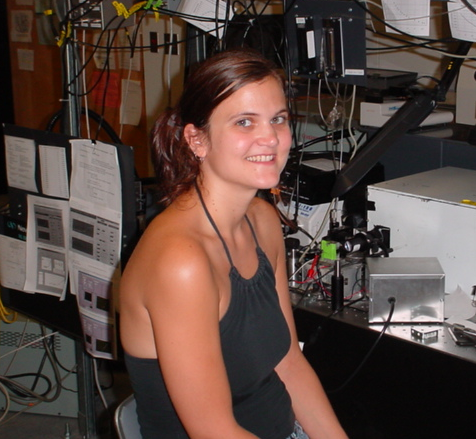Office:
2362 New Physics Bldg.
Lab:
1012 New Physics Bldg.
Contact:
University of Florida
P.O. Box 118440
Gainesville FL 32611-8440
tel. 352-392-4716
fax 352-392-7709
email:
Office hours
see course webpage
Hagen Laboratory Research
The microscopy images at left show individual
V.fischeri cells as illuminated by an external light source
(Dark Field, left) and by their own natural luminescent emission
(Luminescence,right).
The figure below shows the more complex quorum sensing
network that regulates genetic competence in the oral bacterium
Streptococcus mutans. Using microfluidic devices to study the
behavior of this network at the level of individual cells, Finally, the movie below shows an intriguing spreading behavior of a droplet
of liquid containing the soil bacterium Sinorhizobium meliloti that
has been deposited onto a moist surface. In this curious collective
behavior the bacteria use quorum sensing to activate and harness entropic
(thermophysical) forces in their environment. These forces generate
complex patterns of cellular aggregation and spreading.
 In our laboratory we study the dynamics of biological
systems. Areas of interest include protein conformational dynamics and
folding, which we have studied using time-resolved laser fluorescence and
absorption spectroscopy. More recently we have been studying dynamics
of gene regulatory systems. We are particularly interested in the
dynamics of bacterial quorum sensing. Quorum sensing is a mechanism
by which bacteria communicate with each other and detect their own
population density through the exchange of chemical signals. We are using
microfluidic devices to control and manipulate bacterial environments so
that we can study the ways that bacteria use quorum sensing to probe and
respond to their local environment. The diagram at upper left is a rough
schematic of the quorum sensing gene regulatory network of Vibrio
fischeri, a bioluminescent (light-emitting) marine bacterium that
lives in symbiosis with several fish and squid species.
In our laboratory we study the dynamics of biological
systems. Areas of interest include protein conformational dynamics and
folding, which we have studied using time-resolved laser fluorescence and
absorption spectroscopy. More recently we have been studying dynamics
of gene regulatory systems. We are particularly interested in the
dynamics of bacterial quorum sensing. Quorum sensing is a mechanism
by which bacteria communicate with each other and detect their own
population density through the exchange of chemical signals. We are using
microfluidic devices to control and manipulate bacterial environments so
that we can study the ways that bacteria use quorum sensing to probe and
respond to their local environment. The diagram at upper left is a rough
schematic of the quorum sensing gene regulatory network of Vibrio
fischeri, a bioluminescent (light-emitting) marine bacterium that
lives in symbiosis with several fish and squid species.  This network controls the luminescence output of
the bacterium, in response to levels of chemical signals (red symbols)
received from other bacteria.
This network controls the luminescence output of
the bacterium, in response to levels of chemical signals (red symbols)
received from other bacteria. 

Graduate Students |
Undergraduates |
Equipment |
Contact
Graduate Students










Undergraduate Students
(Email corrections and updates to sjhagen at ufl.edu)
| Erik Sjolander | Melissa R. Sarantos6 | Rupika Madhavan2 (REU) (BS 2013) | (incomplete listing)


Major Equipment
- Nikon TE2000U Inverted Fluorescence Microscope with Coolsnap HQ2 camera - This microscope is enclosed in a temperature- and atmosphere- controlled chamber, which was expertly constructed by the UF Physics Machine Shop.
- Laser Temperature Jump Fluorescence Spectrometer - This instrument allows us to collect complete fluorescence spectra (with UV laser excitation) of a protein following an IR laser temperature jump. Time resolution extends from ~20 ns to ~ 0.1 ms.
- Aviv 202 Circular Dichroism Spectrometer - We do make this machine available to other UF researchers. However we do not have resources to provide extensive user training. If you are already experienced in the use of CD spectrometers and you would like to use this machine, please contact Dr. Hagen directly.
- Optical trap
Contact Information